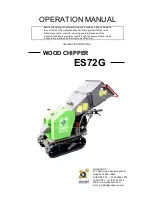
39
Fig. 39 — MBC Cavity Details
Inspect Heat Exchanger Tubes and Flow Devices
EVAPORATOR AND OPTIONAL FLOW DEVICES
Inspect and clean the evaporator tubes at the end of the first oper-
ating season. Because these tubes have internal ridges, a rotary-
type tube cleaning system is needed to fully clean the tubes. In-
spect the tubes’ condition to determine the scheduled frequency
for future cleaning and to determine whether water treatment in
the chilled water/brine circuit is adequate. Inspect the entering and
leaving chilled water temperature sensors and flow devices for
signs of corrosion or scale. Replace a sensor or Schrader fitting if
corroded or remove any scale if found.
CONDENSER AND OPTIONAL FLOW DEVICES
Since this water circuit is usually an open-type system, the tubes
may be subject to contamination and scale. Clean the condenser
tubes with a rotary tube cleaning system at least once per year and
more often if the water is contaminated. Inspect the entering and
leaving condenser water sensors and flow devices for signs of cor-
rosion or scale. Replace the sensor or Schrader fitting if corroded
or remove any scale if found.
Higher than normal condenser pressures, together with the inabili-
ty to reach full refrigeration load, usually indicate dirty tubes or air
in the chiller. If the refrigeration log indicates a rise above normal
condenser pressures, check the condenser refrigerant temperature
against the leaving condenser water temperature. If this reading is
more than what the design difference is supposed to be, the con-
denser tubes may be dirty, water flow may be incorrect, or non-
condensables have contaminated the refrigerant circuit. To re-
solve, check the purge status. If purge is operating normally and
does not have excessive run time, that may be an indication to
double check pressure transducer and temperature readings along
with flow.
During the tube cleaning process, use brushes specially designed
to avoid scraping and scratching the tube wall. Contact your Carri-
er representative to obtain these brushes. Do not use wire brushes.
Hard scale may require chemical treatment for its prevention or re-
moval. Consult a water treatment specialist for proper treatment.
Water Leaks
The refrigerant moisture indicator on the refrigerant motor
cooling line along with the moisture indicator located on the
main and economizer exv indicates whether there is water or
air leakage during chiller operation. Water leaks should be re-
paired immediately.
DESICCANT PACK
MOUNTING BRACE
DESICCANT
PACK
O-RING
CAUTION
The chiller must be dehydrated after repair of water leaks or
damage may result. See Chiller Dehydration section, page 21.
Summary of Contents for AquaEdge 19MV
Page 49: ...49 Fig 46 SIOB...
Page 50: ...50 Fig 47 IOB2...
Page 51: ...51 Fig 48 19MV Auxiliary Controls Wiring...
















































